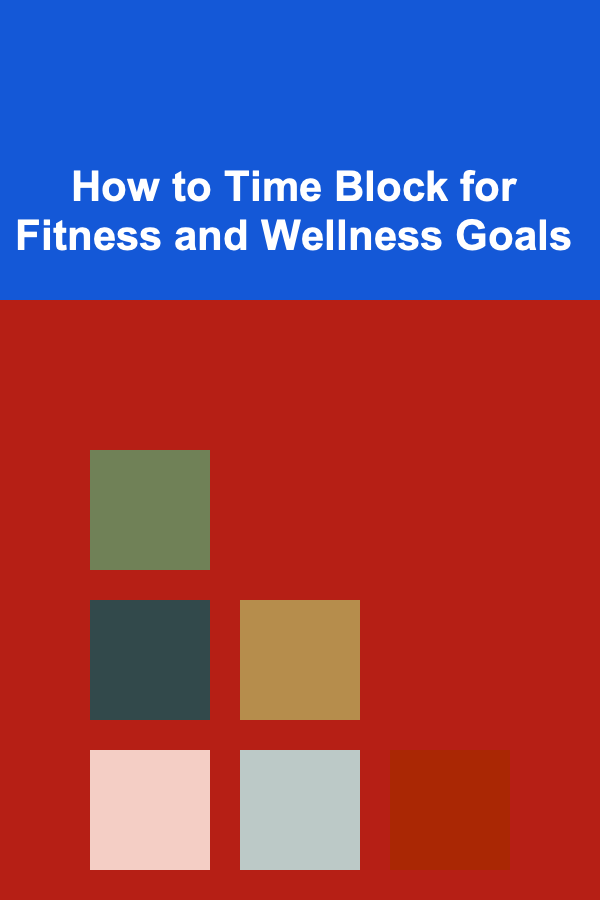
How to Time Block for Fitness and Wellness Goals
ebook include PDF & Audio bundle (Micro Guide)
$12.99$6.99
Limited Time Offer! Order within the next:

Time blocking is an incredibly powerful productivity tool that helps you allocate specific periods during the day to accomplish particular tasks or goals. While it's commonly used for work-related tasks, time blocking can also be a game-changer when applied to personal goals---especially fitness and wellness. The modern world is often busy and filled with distractions, making it challenging to find time for self-care. However, with a time-blocking strategy, you can ensure that you prioritize your health and wellness and follow through with the necessary steps to meet your fitness goals.
In this article, we'll explore how to use time blocking to effectively plan and achieve your fitness and wellness goals. Whether you want to build muscle, improve flexibility, reduce stress, or simply maintain a healthy lifestyle, time blocking can help you stay on track and create a routine that aligns with your objectives.
What is Time Blocking?
Time blocking is a time management technique in which you divide your day into discrete blocks of time. During each block, you focus solely on one task or activity, which eliminates distractions and increases your productivity. This method is designed to optimize your energy, focus, and efficiency by giving each task the attention it deserves.
In the context of fitness and wellness, time blocking allows you to dedicate specific blocks of time each day to workouts, meal prep, recovery, meditation, and other wellness practices. The idea is to treat your wellness as an important and non-negotiable task, just like work meetings or deadlines. Time blocking helps you be intentional about your health goals and ensures that you're consistently making progress.
The Importance of Time Blocking for Fitness and Wellness
The reason time blocking is so effective for fitness and wellness goals is that it provides structure and consistency. If you don't have a specific plan in place for your daily or weekly routines, it's easy to fall into a pattern of skipping workouts or neglecting your self-care. Time blocking helps you:
- Make Health a Priority: By blocking out time for your fitness and wellness routines, you are consciously prioritizing them over other distractions or commitments. You are telling yourself that your well-being is as important as other obligations.
- Increase Accountability: When you have a set schedule, you're less likely to make excuses or skip workouts. Time blocking creates accountability to follow through with your plans.
- Reduce Decision Fatigue: When you have a clear schedule for fitness and wellness activities, you eliminate the need to decide what to do next, which can often lead to procrastination. The plan is already set---just follow it.
- Optimize Your Energy: Time blocking helps you align your workouts and wellness practices with the times of the day when you feel most energized, allowing you to work more efficiently and get better results.
- Prevent Overwhelm: Time blocking breaks down your wellness routine into manageable chunks, making it easier to stay consistent without feeling overwhelmed by the demands of your fitness goals.
Step-by-Step Guide to Time Blocking for Fitness and Wellness Goals
1. Define Your Fitness and Wellness Goals
Before you begin blocking time, it's essential to define your specific fitness and wellness goals. Fitness and wellness can mean different things to different people, so it's important to clearly understand what you're aiming for.
Consider the following types of goals:
- Fitness Goals: These might include weight loss, strength training, building endurance, increasing flexibility, or training for an event like a marathon.
- Wellness Goals: These could involve stress reduction, improving sleep, eating healthier, practicing mindfulness, or maintaining emotional well-being.
By being specific about your goals, you can better structure your time blocks to meet these objectives. For instance, if your goal is to lose weight, you'll need to allocate time for both exercise and meal prep. If your focus is on mental wellness, you might want to dedicate time to mindfulness practices or journaling.
2. Break Down Your Goals Into Actionable Tasks
Once you've defined your goals, break them down into smaller, actionable tasks. For example, if your goal is to build muscle, you might break that into sub-goals like:
- Strength training three times a week
- Increasing protein intake
- Tracking progress with measurements and weights
If you're aiming for better mental wellness, tasks could include:
- Practicing mindfulness daily
- Journaling for 10 minutes every morning
- Taking breaks during work to reduce stress
The clearer and more specific your tasks are, the easier it will be to assign time blocks for them.
3. Assess Your Schedule and Identify Time Blocks
Take a look at your daily or weekly schedule and identify available time slots where you can fit in your fitness and wellness activities. This might include early mornings, lunch breaks, or evenings. When assessing your schedule, consider the following:
- Energy Levels: Schedule your workouts during times of day when you feel most energized. For example, if you're a morning person, try to fit in a workout first thing in the morning. If you feel more energized in the afternoon or evening, plan your workout accordingly.
- Duration: Estimate how long each activity will take. Fitness sessions might take anywhere from 30 minutes to an hour, while wellness activities like meditation or meal prepping could be shorter or longer, depending on the task.
- Consistency: Aim for consistency in your time blocking. It's better to schedule shorter, consistent workouts every day than to schedule one long session sporadically.
4. Prioritize and Block Out Time for Fitness and Wellness Activities
Using the available time slots you've identified, now it's time to allocate specific blocks for each task. This is the actual "time-blocking" process. For instance:
- Morning Block (6:00 AM -- 7:00 AM): Workout (Strength training or Cardio)
- Midday Block (12:00 PM -- 12:30 PM): Meal prep or Eating a healthy lunch
- Afternoon Block (4:00 PM -- 4:15 PM): Mindfulness (Meditation or deep breathing exercises)
- Evening Block (8:00 PM -- 9:00 PM): Relaxation (Stretching, journaling, or reading)
It's important to treat each time block as non-negotiable. Once the time for that activity has arrived, focus solely on the task at hand, whether that's exercising or practicing wellness routines. This also means turning off distractions like your phone or work emails.
5. Build Flexibility into Your Schedule
Life can be unpredictable, and sometimes things don't go as planned. One of the benefits of time blocking is that it allows you to adjust and adapt as needed. However, it's important not to use flexibility as an excuse to skip your fitness and wellness routines entirely.
- Be Realistic: Life happens, and it's okay to occasionally miss a workout or wellness activity. Instead of feeling guilty, simply adjust your schedule and get back on track the next day.
- Buffer Time: If possible, add buffer time between your time blocks to account for unexpected interruptions. This is especially helpful if you have a busy workday or family responsibilities.
- Rest Days: Rest is a crucial component of any fitness routine. Schedule rest days as part of your time-blocking schedule to allow your body to recover.
6. Track Progress and Adjust Your Blocks
To ensure you're staying on track, it's essential to track your progress regularly. This could involve tracking your workouts, nutrition, sleep, and mental wellness activities. Additionally, periodically review your time blocks to assess how well they're working. Ask yourself the following:
- Are you sticking to your time-blocked schedule?
- Are there certain times of day when you feel less motivated or more likely to skip activities?
- Do you need more rest or more intensity in your workouts?
If your current schedule isn't working, don't be afraid to adjust it. Flexibility within your time-blocking system will help you create a plan that's sustainable and effective for long-term results.
Tips for Successful Time Blocking for Fitness and Wellness
- Start Small: If you're new to time blocking, begin with small, manageable tasks and gradually increase the number and complexity of your wellness activities.
- Incorporate Social Support: Time block activities like group workouts or wellness classes to enhance your commitment to fitness. Having a workout buddy or joining a fitness community can increase accountability.
- Use Tools: Use digital calendars (e.g., Google Calendar) or productivity apps like Trello or Notion to visually organize your time blocks and make adjustments as needed.
- Track Results: Use apps or journals to monitor your fitness progress, such as steps walked, calories burned, or meals tracked.
- Reward Yourself: After successfully completing a week of time-blocked fitness and wellness activities, reward yourself with something that motivates you, whether it's a relaxing evening or a special treat.
Conclusion
Time blocking is a powerful tool for achieving fitness and wellness goals. By allocating specific time slots for exercise, meal prep, mindfulness, and recovery, you can make consistent progress toward your health objectives. Time blocking helps eliminate distractions, increase accountability, and optimize energy, all of which are essential for maintaining a successful wellness routine.
Whether you're new to time blocking or looking to refine your existing schedule, the key is consistency, flexibility, and intentionality. By sticking to your blocks and adjusting when necessary, you can take control of your health and wellness journey and make meaningful progress toward your goals.
Reading More From Our Other Websites
- [Scrapbooking Tip 101] How to Master the Art of Layering Embellishments Without Overcrowding
- [Home Family Activity 101] How to Go on a Family Trip to the Library
- [Ziplining Tip 101] Ziplining Hotspots Around the World: Top Destinations for an Unforgettable Ride
- [Personal Care Tips 101] How to Choose a Foundation for Warm or Cool Undertones
- [Home Staging 101] How to Stage a Home for Senior Buyers
- [Personal Finance Management 101] How to Reduce Your Monthly Bills Without Sacrificing Comfort
- [Organization Tip 101] How to Organize Craft Supplies in a Small Apartment
- [Skydiving Tip 101] Best Custom‑Fit Harnesses for Tall Skydivers Over 6 ft Who Need Extra Support
- [Ziplining Tip 101] Soaring Heights: The Ultimate Zipline Routes for Adrenaline Junkies
- [Organization Tip 101] How to Create a Cozy Pet Nook in Your Living Room

Monetize Your Deep Learning Projects: Step-by-Step Guide
Read More
The Dental Hygienist's Playbook: Essential Techniques for Successful Oral Hygiene
Read More
How to Improve Your Bluffing Skills in Board Games
Read More
How To Build Humanoid Robots for Research
Read More
Understanding VR Security and Privacy
Read More
10 Tips for a Sustainable Holiday Planning Checklist
Read MoreOther Products

Monetize Your Deep Learning Projects: Step-by-Step Guide
Read More
The Dental Hygienist's Playbook: Essential Techniques for Successful Oral Hygiene
Read More
How to Improve Your Bluffing Skills in Board Games
Read More
How To Build Humanoid Robots for Research
Read More
Understanding VR Security and Privacy
Read More